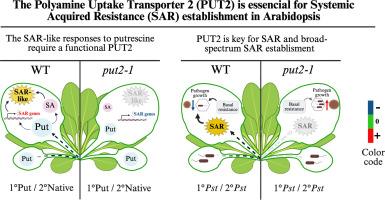Polyamine uptake transporter 2 is essential for systemic acquired resistance establishment in Arabidopsis
IF 6.8
Q1 PLANT SCIENCES
引用次数: 0
Abstract
The study of polyamine transport in plants has become increasingly important due to the central role of these amines in regulating growth, development, adaptation, and stress responses. This research focused on the Arabidopsis thaliana Polyamine Uptake Transporters gene family under conditions of systemic acquired resistance. We evaluated all single mutants of this gene family and found that the put2-1 mutant abolished systemic acquired resistance while enhancing basal resistance to Pseudomonas syringae pv. tomato DC3000. In contrast, the 35S::PUT2 overexpression lines showed improved resistance and reduced bacterial titers compared to wild-type plants. RNA-seq analysis revealed that the put2-1 mutant had deregulated expression of genes involved in the biosynthesis, signaling, and inactivation of salicylic acid and N-hydroxypipecolic acid. Most of these genes were transcriptionally upregulated by putrescine in wild-type plants, but not in the put2-1 mutant. Putrescine supplementation increased endogenous putrescine and salicylic acid levels in wild-type plants but not in put2-1, highlighting the essential role of this transporter in facilitating putrescine mobilization and regulating salicylic acid in distal tissues. We found that the defective systemic acquired resistance phenotype in the put2-1 mutant was linked to changes in the timing of polyamines, ROS, phenolic compound accumulation, and alterations in stomatal immunity. Our study emphasizes the key role of the Polyamine Uptake Transporter 2 (PUT2/LAT4) in establishing systemic acquired resistance in Arabidopsis, while also maintaining the plant’s intrinsic basal resistance mechanisms. These findings offer valuable insights into the complex mechanisms of plant resistance, positioning polyamine transport as a central hub in systemic responses.

多胺摄取转运蛋白2是拟南芥系统获得性抗性建立所必需的
多胺在植物的生长、发育、适应和逆境反应中起着重要的调节作用,因此多胺在植物体内的转运研究变得越来越重要。本文研究了拟南芥多胺摄取转运蛋白基因家族在系统性获得性抗性条件下的表达。我们评估了该基因家族的所有单突变体,发现put2-1突变体消除了系统获得性抗性,同时增强了对丁香假单胞菌pv的基础抗性。番茄DC3000。与野生型相比,35S::PUT2过表达系表现出更高的抗性和降低的细菌滴度。RNA-seq分析显示,put2-1突变体与水杨酸和n -羟基果酸的生物合成、信号传导和失活有关的基因表达失调。在野生型植物中,这些基因中的大多数在腐胺作用下转录上调,但在put2-1突变体中没有。在野生型植物中,补充腐胺增加了内源性腐胺和水杨酸水平,但在put2-1中没有,这突出了该转运体在促进腐胺动员和调节远端组织中水杨酸的重要作用。我们发现put2-1突变体的系统性获得性抗性表型缺陷与多胺、ROS、酚类化合物积累时间的变化和气孔免疫的改变有关。我们的研究强调了多胺摄取转运蛋白2 (PUT2/LAT4)在拟南芥建立系统性获得性抗性的关键作用,同时也维持了植物内在的基础抗性机制。这些发现为植物抗性的复杂机制提供了有价值的见解,将多胺转运定位为系统反应的中心枢纽。
本文章由计算机程序翻译,如有差异,请以英文原文为准。
求助全文
约1分钟内获得全文
求助全文
来源期刊

Plant Stress
PLANT SCIENCES-
CiteScore
5.20
自引率
8.00%
发文量
76
审稿时长
63 days
期刊介绍:
The journal Plant Stress deals with plant (or other photoautotrophs, such as algae, cyanobacteria and lichens) responses to abiotic and biotic stress factors that can result in limited growth and productivity. Such responses can be analyzed and described at a physiological, biochemical and molecular level. Experimental approaches/technologies aiming to improve growth and productivity with a potential for downstream validation under stress conditions will also be considered. Both fundamental and applied research manuscripts are welcome, provided that clear mechanistic hypotheses are made and descriptive approaches are avoided. In addition, high-quality review articles will also be considered, provided they follow a critical approach and stimulate thought for future research avenues.
Plant Stress welcomes high-quality manuscripts related (but not limited) to interactions between plants and:
Lack of water (drought) and excess (flooding),
Salinity stress,
Elevated temperature and/or low temperature (chilling and freezing),
Hypoxia and/or anoxia,
Mineral nutrient excess and/or deficiency,
Heavy metals and/or metalloids,
Plant priming (chemical, biological, physiological, nanomaterial, biostimulant) approaches for improved stress protection,
Viral, phytoplasma, bacterial and fungal plant-pathogen interactions.
The journal welcomes basic and applied research articles, as well as review articles and short communications. All submitted manuscripts will be subject to a thorough peer-reviewing process.
 求助内容:
求助内容: 应助结果提醒方式:
应助结果提醒方式:


